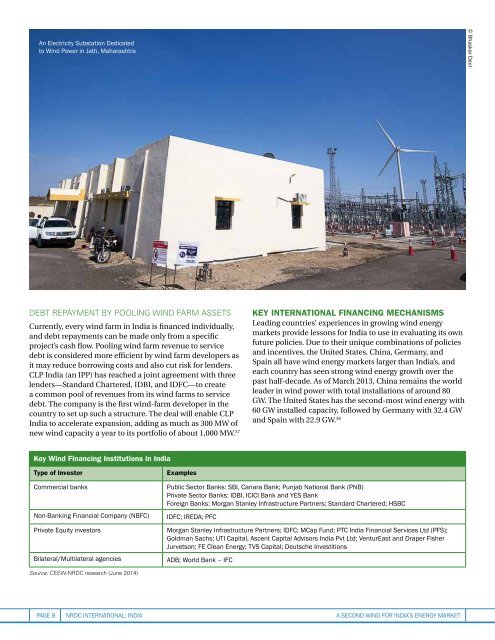India’s National Wind Energy Mission
Shakti Sustainable Energy Foundation has undertaken a study to identify such mechanisms that can support India’s national wind energy mission. Their report highlighted several financing policies, instruments and mechanisms to strengthen India’s wind energy sector. See more at: http://shaktifoundation.in/report/second-wind-indias-energy-market-financing-mechanisms-support-indias-national-wind-energy-mission/
Shakti Sustainable Energy Foundation has undertaken a study to identify such mechanisms that can support India’s national wind energy mission. Their report highlighted several financing policies, instruments and mechanisms to strengthen India’s wind energy sector. See more at: http://shaktifoundation.in/report/second-wind-indias-energy-market-financing-mechanisms-support-indias-national-wind-energy-mission/
You also want an ePaper? Increase the reach of your titles
YUMPU automatically turns print PDFs into web optimized ePapers that Google loves.
An Electricity Substation Dedicated<br />
to <strong>Wind</strong> Power in Jath, Maharashtra<br />
© Bhaskar Deol<br />
Debt Repayment by Pooling <strong>Wind</strong> Farm Assets<br />
Currently, every wind farm in India is financed individually,<br />
and debt repayments can be made only from a specific<br />
project’s cash flow. Pooling wind farm revenue to service<br />
debt is considered more efficient by wind farm developers as<br />
it may reduce borrowing costs and also cut risk for lenders.<br />
CLP India (an IPP) has reached a joint agreement with three<br />
lenders—Standard Chartered, IDBI, and IDFC—to create<br />
a common pool of revenues from its wind farms to service<br />
debt. The company is the first wind-farm developer in the<br />
country to set up such a structure. The deal will enable CLP<br />
India to accelerate expansion, adding as much as 300 MW of<br />
new wind capacity a year to its portfolio of about 1,000 MW. 37<br />
Key International Financing Mechanisms<br />
Leading countries’ experiences in growing wind energy<br />
markets provide lessons for India to use in evaluating its own<br />
future policies. Due to their unique combinations of policies<br />
and incentives, the United States, China, Germany, and<br />
Spain all have wind energy markets larger than <strong>India’s</strong>, and<br />
each country has seen strong wind energy growth over the<br />
past half-decade. As of March 2013, China remains the world<br />
leader in wind power with total installations of around 80<br />
GW. The United States has the second-most wind energy with<br />
60 GW installed capacity, followed by Germany with 32.4 GW<br />
and Spain with 22.9 GW. 38<br />
Key <strong>Wind</strong> Financing Institutions in India<br />
Type of Investor<br />
Commercial banks<br />
Non-Banking Financial Company (NBFC)<br />
Private Equity investors<br />
Bilateral/Multilateral agencies<br />
Examples<br />
Public Sector Banks: SBI, Canara Bank; Punjab <strong>National</strong> Bank (PNB)<br />
Private Sector Banks: IDBI, ICICI Bank and YES Bank<br />
Foreign Banks: Morgan Stanley Infrastructure Partners; Standard Chartered; HSBC<br />
IDFC; IREDA; PFC<br />
Morgan Stanley Infrastructure Partners; IDFC; MCap Fund; PTC India Financial Services Ltd (PFS);<br />
Goldman Sachs; UTI Capital, Ascent Capital Advisors India Pvt Ltd; VenturEast and Draper Fisher<br />
Jurvetson; FE Clean <strong>Energy</strong>; TVS Capital; Deutsche Investitions<br />
ADB; World Bank – IFC<br />
Source: CEEW-NRDC research (June 2014)<br />
page 8<br />
NRDC international: INDIA<br />
A Second <strong>Wind</strong> for <strong>India’s</strong> <strong>Energy</strong> Market

















